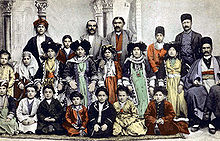Iranian Assyrian

Assyrians from Sena, Persia, around Lake Urmia
|
|
| Total population | |
|---|---|
| 50,000 | |
| Regions with significant populations | |
|
|
|
| Languages | |
| Persian and Neo-Aramaic | |
| Religion | |
| Assyrian Church of the East, Chaldean Catholic Church, Assyrian Pentecostal Church, Assyrian Evangelical Church |
Iranian Assyrians, Persian Assyrians or Assyrians in Iran (Persian: آشوریان ایران), are an ethnoreligious and linguistic minority in present-day Iran. The Assyrians of Iran speak Assyrian Neo-Aramaic, a neo-Aramaic language descended from Classical Syriac and elements of Akkadian, and are Eastern Rite Christians belonging mostly to the Assyrian Church of the East and also to the Chaldean Catholic Church, Syriac Orthodox Church, Ancient Church of the East, Assyrian Pentecostal Church and Assyrian Evangelical Church.
They share a common history and ethnic identity, rooted in shared linguistic, cultural and religious traditions, with Assyrians in Iraq, Assyrians in Turkey and Assyrians in Syria, as well as with the Assyrian diaspora.
The Assyrian community in Iran numbered approximately 200,000 prior to the Islamic Revolution of 1979. However, after the revolution many Assyrians left the country, primarily for the United States; the 1996 Iranian census counted only 32,000 Assyrians. Current estimates of the Assyrian population in Iran range from 32,000 (as of 2005[update]) to 50,000 (as of 2007[update]). The Iranian capital, Tehran, is home to the majority of Iranian Assyrians; however, approximately 15,000 Assyrians reside in northern Iran, in Urmia and various Assyrian villages in the surrounding area.
...
Wikipedia
